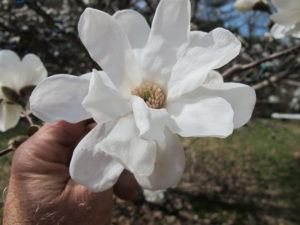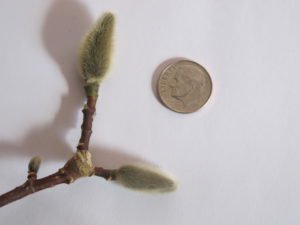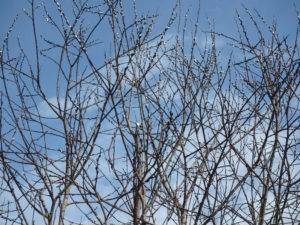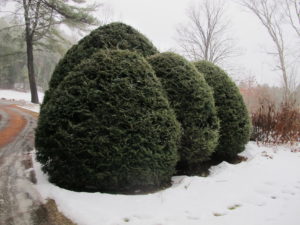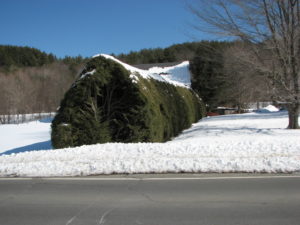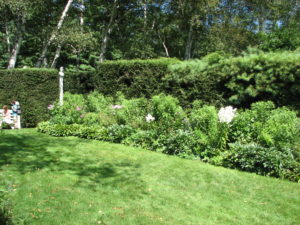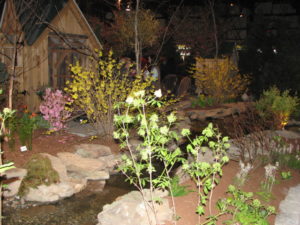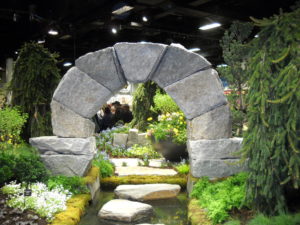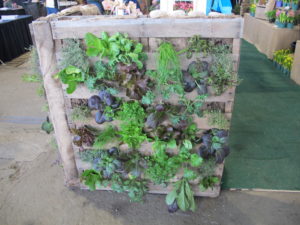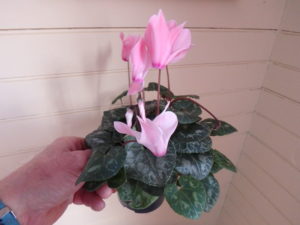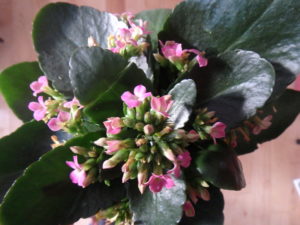Forcing Flowers of Shrubs and Trees
When I was in first grade we learned a song about pussy willows that still rings in my head when I walk past the fire pond in Cornish Flat. Or it did recently when I saw pussy willows starting to pop open in a marshy area. Spring is here.
Pussy willows are actually the flowers of a wild shrub or small tree, the goat or pussy willow, also known by its scientific name, Salix caprea. This willow is a native to the United States and grows best in moist or soggy soils, or even in standing water. Full sun is best, but it can grow in part sun. It will grow up to 25 feet tall, but 15 feet is more common. The flowers grow on the top of the plant, so I use a pole pruner to get the branches I want.
Another willow, Salix discolor, is also a pussy willows but is “susceptible to a canker and is considered inferior for landscape use, though neither species is a plant of the first order.” That according to Michael Dirr in his book Manual of Woody Landscape Plants which I consider my bible of trees and shrubs.
He is right about pussy willows not being plants of the first order. Their time of glory is the spring, when the catkins or blossoms appear. The rest of the year it is a relatively unkempt, messy plant that spreads and is often too large to be considered a shrub, but not big enough to be considered a tree. The stems are weak, sometimes flopping over and easily breaking in ice storms. Still, if you have a wet area on your property, and like fat, fuzzy pussy willows in the spring, you should have some.
When I picked some pussy willow stems recently, I put them in a vase with water. This will encourage un-opened buds to open. Later, when all the blossoms are fully open, I will pour out the water and allow the stems to remain in a dry vase. This will prevent them from producing yellow pollen (which will fall on the table top) and allow me to have the fuzzies forever, or at as long as I want. One year, inadvertently, I kept a vase of pussy willows for a full year, and they still looked good!
Another plant that can be forced to flower now looks similar to pussy willows at a quick look. I have a tree covered with fuzzy buds that are actually unopened flower buds that look like the pussy willow flowers. The hybrid magnolia ‘Merrill’ has these buds all winter, but when put in water now the buds will produce large white blossoms. Other magnolias have similar buds – like pussy willows on steroids.
The Merrill magnolia will generally bloom for me in late April. The closer to the date of outdoor blooming, the quicker buds will open in a vase indoors. I once did some pruning in December and forced magnolia buds indoors, but it took over a month for that to happen. Now it should happen in half that time (though pussy willow buds will open in just a few days).
My Merrill magnolia is one of my favorite trees. Mine is about 20 or 25 years old, and is roughly 30 feet tall with a 20 foot spread. When it blooms the flowers are bountiful – a thousand, perhaps – and magnificent. Each blossom is about 3 inches across and lightly fragrant. I recommend them as specimen trees in the middle of a lawn or field in full sun.
Another classic early spring shrub is forsythia. Like the daffodil, this early bloomer is bright yellow, a color I have come to associate with spring. It can be used as a hedge, or pruned into a vase-shaped shrub that stays relatively small, say 8 feet tall and 6 feet wide.
To get forsythia to bloom, pick stems that are more than one year old. New stems are generally straight, with few side branches and even fewer buds. The buds on new branches tend to be leaf buds. Older branches will be branched, and loaded with flower buds. And for best results, don’t forget to change the water in the vase every 2 or 3 days.
Forsythia is a nice enough plant, but like pussy willows, it is not my favorite. It is rambunctious, for starters. It wants to take over the world, sending out roots that then send up new plants. My neighbor planted a forsythia hedge, and now I have forsythia that has encroached onto my land. Fortunately, it is easy enough to control if you pull out new shoots early on. Or failing that, cut them back every year.
As a child, however, I loved forsythia. My gardening grandfather planted a double row of them between the house and the vegetable garden. As the plants grew and spread they became a dense thicket perhaps 40 feet long, 10 feet wide and 10 feet tall. My sister Ruth Anne and I discovered that if we crawled into this thicket there was a hidden ”room” in the middle where we could hide from adults on hot summer days.
Apple blossoms are great for forcing, too. When I prune in March I take branches with short fruit spurs, put them in a vase, and get flowers. At this time of year, one can’t have too many blossoms!
Read Henry’s twice-weekly blog at https://dailyuv.com/
Hedges: Great Windbreaks for Winter
Although I’ve never read a scientific paper on the value of hedges for garden plants, my personal theory is that they are beneficial, particularly in winter. They break the cold winter winds that damage flower buds on trees and shrubs in cold times and can help keep soil from drying out from hot, dry winds in summer. Easier to install and less expensive than wood fences or stone walls, this is a good time to think about planting a hedge, come summer.
Hedges can be grown using almost any plant material that survives our winters – or even those that die back to the ground each winter. For most of us, the important thing is that they look good, be affordable and grow relatively quickly.
If you want a tall hedge to screen an eyesore or provide privacy, you should select a woody evergreen hedge. Canadian hemlock if good for that – it grows fast and will grow close together. For a 6-foot hedge, plant hemlocks 6 feet apart. For an 8-foot hedge, 8 feet apart, and so on. Yew is also good, but generally is pruned to stay lower and deer love to eat it. Boxwood and privet are traditional hedges, but privet (a deciduous shrub) is now considered an invasive plant in many places and discouraged or prohibited.
In order to keep an evergreen hedge looking good, you need to taper it so that the bottom has longer branches than those on top. That allows the lower branches to get more sunlight.
When planting a shrub or tree for hedging you should start with small plants, plant them close together, prune early on, and prune hard. By pruning early and hard you encourage good branching down low, so you don’t end up with a gawky hedge with little greenery near the bottom.
It’s best to prune your hedge one to three times each summer, even when they are small – to encourage branching and maintain a thick hedge. If you don’t prune every year, your hedge will have thick, stubby branches when you cut it back instead of small, feathery branches. And it can get too tall.
Cost is an issue when selecting plants for hedges, as they require many plants. Ideally you can use plant material that you own and can divide and use for free. I’ve rooted willow twigs to create a small wall. Lilacs often send out root suckers that can be dug up and moved. According to what I’ve read, other good candidates for rooting include elder, flowering quince, forsythia, mock orange, rugosa rose, spirea, viburnums and witch hazel.
Creative pruning of hedges can create dramatic results. There is no reason why a flat and “boring” hedge cannot be pruned to different heights to create a wave of green mimicking a distant view, or shaped to have a pointy top or be shaped like a dome. And you can trim a hedge to different heights at different places to open up a view – or hide the abandoned car on your neighbor’s property.
In addition to the usual hedge plants, edible hedges can be made using gooseberries, currants or blueberries. Decorative grasses can be used, or even golden rod (if you dare risk the scorn of your neighbors). I once divided and moved several large peonies for a client who was re-doing a garden. I divided them into 50 plants and spaced them so that, when mature, the foliage would mingle and create a single row of plants. By now it must be drop-dead gorgeous in June. It’s not a hedge that provides privacy, but it is wonderful in bloom and it sets off their lawn from the neighbor’s lawn.
Lastly, you can make a hedge by installing (or utilizing an existing fence) and growing vines on it. Evergreen euonymus (Euonymus fortunei) is an evergreen variegated-leafed vine that will grow in shade and is quite vigorous. And most vines will start easily from cuttings. English ivy, Virginia creeper, or even grapes can be used. When they mature, the fence disappears, and you have a wall of green. Climbing hydrangea will not attach to a wooden fence, but it can be attached to one, and will grow in full shade and flowers magnificently.
A word of caution: if you are using a hedge as a separation of your property from a neighbor’s, remember that the neighbor should be consulted, as they will have to trim their side of the hedge. Or plant it far enough back from the property line that you can trim both sides, without stepping off your own property.
Your hedge probably won’t serve to keep out hungry animals. Deer are really the only ones you have to worry about in most neighborhoods, and anything less than 8 feet is just an easy leap for all but oldest, most arthritic deer. Still, it will keep out young neighborhood ruffians, particularly if the plants have thorns.
See Henry’s blog at https://dailyuv.com/
Flower Shows
Spring arrives every year, but never soon enough for most of us gardeners. The first real sign of spring for me is always the arrival of my snowdrops: those tiny white bulb flowers that come up, no matter what, by early March – and sometimes earlier. Even under a thick blanket of snow and sub-freezing temperatures, the snow drops pop up. I’ve been known to shovel off the snow to find them.
At the same time come the spring flower shows. These extravaganzas offer the blossoms and fragrances of spring – but months early. Intrepid nursery-people force trees to bloom, along with hundreds of tulips and daffodils. Seed companies are there, showing their wares, and garden experts spout knowledge to interested gardeners in dozens of workshops over the weekend-long events.
The Providence Flower Show was, for the last 20 years, one of the first each year. It was a great show and I attended often. Unfortunately, it saw declining revenues and has given up. Apparently the competition with the Connecticut Flower Show in Hartford and bad winter weather did it in. The Rhode Island Home Show, produced by the Rhode Island Builders Association will have a flower component in their annual show march 30 to April 2.
So this year the first weekend of flower shows is February 23 to 26 at the Hartford Convention Center – and the Connecticut Flower Show reigns by itself. The Hartford Show’s theme this year is “Woodland Enchantment”. There will be over 50 workshops over the course of the weekend, so there is much to learn from their speakers. And of course, there are flowers galore and much to buy if so inclined.
Next comes the Vermont Flower Show on March 3 and 4 at the Champlain Valley Fairgrounds. This is a nice small show. Instead of many small displays of flowers, members of the Vermont Nursery and Landscape Association work together to create one larger area that includes many blooming trees and forced bulbs that is always nice. There is a large model train area that appeals to kids, along with children’s craft opportunities to keep the little ones busy. The vendors of garden-related stuff are numerous.
The “grande dame” of American flower shows, the Philadelphia Flower Show comes next and lasts from March 11 to 19. It is truly huge, and worth visiting at least once. Held in the Pennsylvania Convention Center, it covers about 6 city blocks and will be attended by over a quarter of a million people over a nine-day period. The displays range from the grandiose and outrageously expensive to entries of African violets by little old ladies. It is best to go on a weekday when the crowds are smaller. This show has been annual since 1829, so they know what they are doing!
Then comes the Boston Flower Show, another extravaganza. It will be held March 22 to 26 at the Seaport World Trade Center on the waterfront of Boston. Like the Philly show, it is a good idea to visit on a weekday. This year’s theme is “Superheroes of the Garden”. Their publicity touts it as “honoring the crusaders, innovative tools and legendary plants helping to make us all champions in the battle for garden supremacy!”
Want smaller crowds? Go to the Bangor, Maine Flower Show which will be held that same weekend, March 24 to 26. It will be held in the Cross Insurance Center and will include flower displays, speakers, food and more.
The Maine Flower Show at Thompson’s Point in Portland will be held March 29 to April 2. This is a new venue to me and will certainly be an improvement over the old warehouse that housed it when I last visited this show. According to their promotion, it will feature 16 display gardens and “will have 100 exhibits of plants, hardscape, arbor and garden supplies, and all things relative to outdoor yardscaping and living.”
That same weekend is the New Hampshire Seacoast Home and Garden Show in Durham, NH. Held in the Whittemore Center Arena on April 1 and 2. As the show name indicates, this is not just about flowers, but includes displays and workshops on a variety of home improvement topics.
But for me, the flower show season will wrap up with the biggest and the best, from all I have heard. My partner, Cindy, and I have bought our plane tickets to London to attend the Chelsea Flower Show held this year May 23 to 27. This is a fund raiser for the Royal Hospital Chelsea.
The show is run by the Royal Horticultural Society, and the first 2 days of the show admission is restricted to members only. Membership costs $55 and a ticket for the first day costs $90. The second day the price drops a bit and by the Thursday, the first day open to the public, tickets are a mere $61. Prices go up after April 10. But airfare to London is down this year, which helps.
Unlike American flower shows, the Chelsea flower show includes much that is planted outdoors – which allows garden displays to be even more spectacular. I was told by a friend to take my umbrella! For me, this show is one more item to check off my “bucket list.”
You may reach Henry at henry.homeyer@comcast.net or at P.O. Box 364, Cornish Flat, NH 03746. His web site is www.Gardening-Guy.com.
Four Great Plants to Brighten Up Your House
Winter is tough on many gardeners, myself included. We need flowers blooming and plants to tend. But many of us are not enthralled with standard houseplants because they are often fussy and, if over-watered, too easy to kill. Let me suggest some nice easy, disposable flowers you can get at your local nursery or food coop.
I recently bought 3 blooming primroses for a total of $11.85. One is purple, the others shades of pink. They will bloom for a couple of weeks – or perhaps more. The tags only said ”Primula” (its scientific genus) and “Plant in part shade 8” apart”. The tag did not say, however, if these primroses would survive a New England winter. I suspect not, having babied other grocery store primroses along until the ground thawed and planted them outside. But I don’t care. These lovely plants will provide color and life indoors at a drab time of the year. And for less than $4 each, they don’t have to last forever.
What the tag should have said, however, is “Do not keep this primrose in a hot, sunny window unless you are willing to water regularly.” The soil they are in dries out fast, and you can cook a primrose – and most other grocery store plants – in just a day or two of inattention. I did that recently, but I placed the abused primrose in a deep dish and filled it with water, allowing it to suck up plenty. And it recovered in just a few hours.
I usually add a few drops of a product called “Superthrive” to the water when I have a plant that is suffering from neglect. This liquid contains plant hormones and seaweed extracts, and is very good for helping plants recover from environmental stress. It is expensive if calculated by the ounce, but so little is needed that it is not expensive. And it works. A 4 ounce bottle costs around $10-12.
I also bought a cyclamen in my effort to brighten up the house and do some attitude adjustment. Cyclamen definitely do not want to be in a sunny window. Bright indirect light is best. They come in a range of pinks, reds, magentas and white. I tell when they need watering by lifting the pot. If it feels very light, it’s time to give it water.
Cyclamen keep on blooming for much longer than primroses, and can last for years, getting bigger and better each year. If you want to learn about getting them to re-bloom, find a copy of Thalassa Cruso’s wonderful book, Making Things Grow: A Practical Guide for the Indoor Gardener. It’s out of print, but readily available. Every used bookstore has copies, and it’s a gem. Ms. Cruso was a TV personality, I gather, and her books read the way she must have presented herself – as a friendly, knowledgeable auntie.
Thalassa Cruso was, of course, a plant fanatic. I’m not sure that following every bit of her advice is worth the trouble. She notes that cyclamen come originally from Iran where they bloom in winter. She claimed to move hers every evening to a cool spot such as a mudroom where the temperature is below 60 degrees. My goodness, it’s enough for me to turn off all the lights, feed the woodstove and the cat, take out the dog and brush my teeth before going to bed. Now I learn I should be moving the cyclamen, too!
Cineria is another gem available at this time of year. It has the added advantage of a lovely fragrance, too. It appears as a mound of daisy-like flowers that stand up a good 10 inches. It wants bright light, but no direct sunshine (they will finish up too quickly in the sun). Its soil needs to be kept moist, but not soggy.
Cineria are true annuals. That means that once the 6-weeks of blooming is over, the plant is done. You cannot get it to survive, year after year, returning to bloom again. That’s a blessing. You can feel fine about throwing it in the compost. It’s a no-guilt plant.
The last of my recent investments was a kalanchoe. This is a succulent and does will in warm, dry conditions. It comes in a variety of colors. In Thalassa Cruso’s book it was described in the chapter “Neglectable Plants”. That means, I suppose, it is hard to kill them. This one will, apparently, re-bloom if you cut it back after blooming, and reduce the light for a month, and don’t water it then, either.
So go get some plants in bloom for the house. No matter what you do, they should last longer than the same money invested in cut flowers, so they are a good investment. Just don’t think of them as a lifetime investment and you’ll be happy. Let them bloom, and toss them if you wish. I often do.
Read Henry’s blog twice a week at https://dailyuv.com/



